Learn about Growing Plants, Horticulture and Gardening
- Gain a broad technical grounding in horticultural principles and practice.
- The ideal course for the beginner, this is a basic, yet thoroughly practical course. A section of each lesson involves plant identification.
- This subject has been written to teach horticulture in a way that is relevant to all parts of the world. It puts aside regional techniques, and tries to teach you principles and concepts which can be applied to anywhere.
 Horticulture
is a massive employer in most countries around the world: giving us
much of the food we eat, the parks, gardens and sports grounds we play
in and much more.
Horticulture
is a massive employer in most countries around the world: giving us
much of the food we eat, the parks, gardens and sports grounds we play
in and much more.
With many thousands of successful graduates,
this course has been the starting point that underpins businesses and
careers for countless numbers of people across every corner of the
world.
If you want to start a business; increase your
job opportunities or take a career to the next level; this course does
precisely that for anyone who has not formally studied horticulture
before.
Comment from a student: " I really appreciate Gavin's (tutor) comments and look forward to receiving the feedback from him." - Nadine